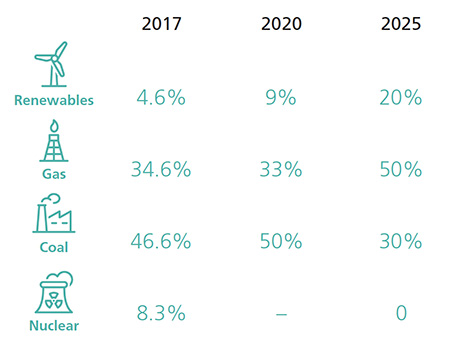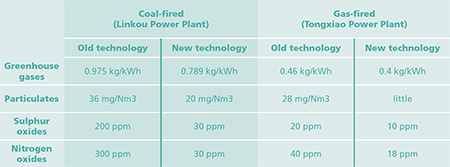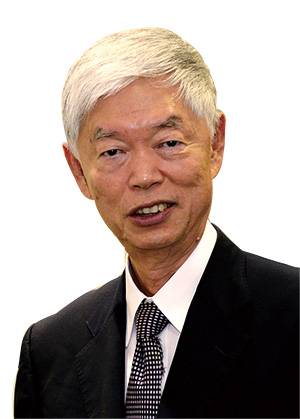Professor Chi-yuan Liang, Chair Professor at the National Central University of Taiwan, gave a City Seminar presentation on A Prospect for Taiwan's Post-Referendum Energy Policy in June. Professor Liang questioned whether the government's vision of a non-nuclear future will be feasible given constraints around natural gas and renewables, along with the population's continued opposition to expanding coal-fired plants.
In November 2018, Taiwan went through a major democratic exercise, holding referendums on ten issues including energy. How successful was the exercise?
| Taiwan energy referendum |
|---|
- Against air pollution – reduce output of thermal power plants 1% year-on-year.
- Stop construction of coal-fired thermal power plants.
- Go green simultaneously with nuclear.
|
Energy transformation policy of Taiwan
Of the ten referendums, three were on energy issues. This reflects the discontent of citizens on recent electricity shortages and air pollution, and rising doubt about the government's energy transformation policy. The referendums were: firstly, against air pollution – to reduce by 1% year-on-year the electricity production of thermal power plants. Secondly, to stop construction of any coal-fired thermal power plants. And thirdly, to go green simultaneously with nuclear, that is to repeal part of a recent electricity act to completely stop nuclear-energy-based power generating facilities by 2025. All three referendums related to energy were passed but are non-binding in effect, so the plan to make Taiwan nuclear-free by 2025 need not be affected by the referendum results.
Can Taiwan achieve 20% renewables by 2025?
There are constraints on Taiwan's low carbon energy development. Taiwan is one of the most densely populated regions in the world, and is characterised by fragmented land ownership making buyouts complicated and time consuming. In order to achieve 20% renewables, the government projects that 73% of capacity will be solar. But finding the 25,500 hectares land required for ground-mounted solar PV instalment is a problem.
As for wind power, Taiwan has established 336 on-shore turbines along less than 200 km of coast line, but typhoons, earthquakes, environment protection, and fisherman and navigation disputes are causing problems for further development. On-shore turbines have also attracted protests from environmental groups and residents. Where are we going to build another 260 turbines in the coming six years as required? Overall, we can say that the implementation of solar power and wind power is behind schedule, and it is highly questionable whether the 20% target can be achieved by 2025.
How far is Germany's energy transformation a model for Taiwan?
Germany has been particularly successful in the development of renewable energy. But geographically, Germany is very differently situated to Taiwan, and can either import or export its electricity to neighbouring European countries through a continental grid. Taiwan's electricity grid, by contrast, is independent and isolated. Due to its unstable characteristic, renewable energy cannot substitute for base-load power plant, such as nuclear and coal-fired plant.
It is worth noting that electricity prices in Germany have risen sharply, and that due to the elimination of nuclear and the reintroduction of some coal, there has been an increase in green-house gas emissions.
Also, we need to check the feasibility of the scheduling. Germany decided to abolish all nuclear power in the year 2000, but in 2019 nuclear still accounted for 13% of electricity generation. By contrast, Taiwan's government will close all nuclear power plants by 2025, in addition to abolishing an almost completed nuclear plant (Lungmen Nuclear Power Plant). The policy change is drastic while the time to execute is too short.
What is the role of natural gas in Taiwan's energy supply?
Taiwan's gas is mostly imported in the form of Liquefied Natural Gas (LNG). The cost of gas-fired LNG plant is higher than coal but the CO2 emissions are about half. To substitute four nuclear plants with gas-fired power, the electricity price will increase by 40% from the 2013 price. Gas-fired power accounted for 34.6% in the total electricity generation in 2017, one of the highest percentages in the world, even higher than in gas abundant countries such as the United States (31.9%). According to government energy transformation policy, the share of gas-fired power in electricity generation will increase to 50% by 2025.
The cost of electricity in Taiwan (NTD)
| Blackout |
|---|
|
The frailty of Taiwan's energy supply was highlighted by an island-wide blackout in August 2018. Supply to the largest gas-fired power plant was accidentally shut down, causing a 4.4 GW plant to go offline. With insufficient reserve capacity to make up for the shortfall, more than six million households and hundreds of industrial users were impacted. In the months before the blackout, reserve margins went as low as 2%, far below a country's typical 10% -15% comfort levels.
|
Environmental costs of coal and gas
Source: Taiwan Power Company
However, the stockpiling of LNG is very low, only 13 days on average over the year, and as low as 7 days in the summer time. This compares to Korea (53 days), mainland China (51 days), and Japan (36 days). Taiwan's LNG stockpiling capacity is too low to be accepted as secure, as was seen in the August 2018 blackout. If two typhoons hit Taiwan within a week, energy security would be threatened.
What impact has the Fukushima nuclear accident had on the international community?
Of the countries with nuclear power programmes, 27 countries are unchanged and continue to develop nuclear energy. This includes three countries which have experienced nuclear accidents – The United States, Russia and Japan. Only Germany, Switzerland, Belgium and Taiwan will end the development of nuclear.
What do you see as the role of nuclear in Taiwan?
The current "zero nuclear policy" diverges from the international trend of energy development, and is not a mainstream policy. Also, the projection on reserve margin rate during 2017-2025 made by the government is too optimistic. The reoperation of Nuclear 2 could help relieve the electricity shortages of recent years.
However, Taiwan still needs to face the challenge of 11% loss in electricity supply during 2021-2025 due to the zero nuclear policy. That will cause five major problems: electricity shortages, regional electricity unbalance, price surges, out-of-control carbon emissions, and energy insecurity. These impacts will affect Taiwan's economic growth and employment outlook. In the light of this, I believe that the Nuclear 4 Power Plant should be recommissioned.
What is the optimal electricity mix in Taiwan for 2025?
Considering external environmental costs (US$40/ metric tonne CO2), the optimal electricity mix in 2025 would be 32.5% coal-fired power generation, 40% gas-fired, 10% renewables, and 17.5% nuclear. This would avoid the problems caused by the government's current energy transformation policy. And most importantly, this energy mix would comply with the three referendums of November 2018. Consequently, it might serve as an alternative for the government to reformulate its energy policy.
Professor Chi-yuan Liang
Chair Professor
National Central University




